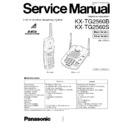Panasonic KX-TG2560B / KX-TG2560S Service Manual ▷ View online
46
KX-TG2560B/KX-TG2560S
17. Telephone Line Interface
Circuit Operation:
• ANSWER
In the idle mode, Q101 is open to cut the DC loop current and decrease the ring load. When ring voltage appears at the Tip (T)
and Ring (R) leads (When the telephone rings), the AC ring voltage is transferred as follows:
T
→
PO101
→
L101
→
R121
→
C116
→
Q106
→
IC701 pin 64.
When the CPU (DSP) detects a ring signal, Q101 turns on, thus providing an off-hook condition (active DC current flow through
the circuit) and the following signal flow is for the voice signal.
T
→
PO101
→
D101
→
Q101
→
Q105
→
R115
→
D106
→
D101
→
R
• ON HOOK
Q101 is open, Q101 is connected as to cut the DC loop current and to cut the voice signal. The unit is consequently in an
on-hook condition.
• SPECIFICATIONS
In the on-hook state (idle), the current flows between the telephone line and the unit is as follows:
T
→
PO101
→
L101
→
R121
→
C116
→
R122
→
C115
→
R120
→
L102
→
R.
The DC component is blocked by C115, C116: thereby providing an on-hook condition.
The AC interface impedance is over 47 K
Ω
thus, satisfying the telephone company requirements.
18. Intercom Mode
1. When LOCATOR/INTERCOM button of the base unit is pressed, a call monitor signal (intercom sound) is output from pins
32 and33 of C701. Thus a monitor tone is heard from the speaker.
2. At the same time, pin 25 of IC701 goes “Low”, and the transmission state is reached. Then the modulated data signal is
outputfrom pin 97 of IC701. Flashing of the IN USE/CHARGE (LED701) is obtained from pin 65 of IC701. This status is called
“Intercom stand-by”.
3. The receiving signal flows:
RF
→
pin 13 of CN102
→
C423
→
R424
→
VR402
→
C419
→
R418
→
R417
→
pin 9 of IC401
→
pin 12 of IC401
→
C409
→
R414
→
pin 13 of IC401
→
pin 14 of IC401
→
C407
→
R412
→
C718
→
R711
→
pin 45 of IC701
→
pins 32 and 33 of IC701
→
SP
4. The transmission signal flows:
MIC
→
C715
→
C714
→
C733
→
R755
→
pin 47 of IC701
→
pin 35 of IC701
→
C410
→
R415
→
C411
→
pin 3 of IC401
→
pin 6 of IC401
→
C425
→
R408
→
R421
→
VR401
→
pin 2 of IC801
→
RF
Circuit Diagram
D105
D102
C108
R116
R118
R115
R113
C111
Q105
C113
R117
R114
C107
C106
R112
C110
C709
R103
C105
L101
PO101
SA101
1
2
2
T
R
L102
R122
R123
Vcc
To IC701 64
(Bell)
(Bell)
Q106
R120
D101
3
4
2
1
R121
R101
Q101
Q102
R104
R105
R102
C117
C115
C116
C103
C104
C118
To IC701 99pin
(RLY)
(RLY)
To IC701 40pin
(EX-Hook)
(EX-Hook)
~ +
~ -
D106
R124
47
KX-TG2560B/KX-TG2560S
19. Initializing Circuit
Function:
This circuit is used for to initialize the microcomputer when it incorporates an AC adaptor.
Circuit Operation:
When the AC Adaptor is inserted into the unit, then the voltage is shifted by D303 and power is supplied to the CPU.
The set can operate correctiy by this Initalizing.
Circuit Diagram
12
56
IC701
D303
D902
D306
C305
R307
R301
Q303
Q301
R302
D301
R304
Q751
C758
Q752
R752
R754
D750
R306
2
3
IN OUT
GND
1
Power Down
1
2
2
+
-
-
L302
D900
L303
Vcc
Reset
C705
R751
R707
R753
48
KX-TG2560B/KX-TG2560S
LC
Filter
Filter
Power
Amp
Amp
Driver
Amp
Amp
Ceramic
Filter
Filter
2440MHz
1220MHz
FL750
Ceramic
Filter
Filter
915MHz
FL730
Q731
Q730
Q830
LNA
AGC
TXPN
33
37
42
45
X2
PLL
PLL
Ref
TXVCO
LC Filter
PN generator
PN generator
(Sliding)
(Sliding)
LC Filter
A/D
Logic
PLLIC
@
IC750
IFIC
@
IC800
X790
2,3
11,10
39,37
19
28
18
20
23
14
6,7
1
3
12
26
16
1
12
40.960MHz
870MHz
RX VCO
Limiter
RSSI
Comp
Comp
Rect
Det
Comp
IFAMP
Amp
SS ASIC
@
IC920
TXRST
40HzStart
34
18
24
19
4
38
22
29
11
44
36
SSRST
41
SSEN
RXRST
RSSI1
SSLOCK
Data,CLK
PLLEN
MOD
TXDATA
RSSI2
AFOUT
RXDATA
SQR
Q930
CLK
RXPN
10
11
16
11
16
5
22
AF
AMP
AMP
Active Filter
IC910
Q800
SQ
Ceramic
Disc.
Disc.
10.8MHz
Filter
Filter
51.76MHz
Filter
Filter
Noise
Filter
Filter
L800
FL801
FL800
26
23
IC701
Q720
BLOCK DIA
GRAM (Base Unit-RF)
RF-Unit
49
KX-TG2560B/KX-TG2560S
TXVCO
1200MHz
1200MHz
PN code
IC920
IC920
2.4GHz
SS signal
SS signal
18
NEW CIRCUIT OPERATION (Base Unit-RF)
1. TX Doubler / Spreader
2. Driver Amplifier / Power Amplifier
The signal of 1200MHz is input from pin 42
of IC750. At first, TX Doubler (internal) makes this signal to 2400 MHz, then this
signal goes to Spreader (internal).
PN code* from pin 18
PN code* from pin 18
of IC920 is input to pin 37
of IC750, causing the input signal coming from TX Doubler (internal).
The spread signal is output from pin 33
of IC750.
The spread signal output from pin 33
of IC750 is input to pin 4
of Driver Amp. Q720 through FL750 (2400 MHz BPF). Q720
increases the level approximately 15dB, then it is output from pin 2 . This signal is input from pin 5 of IC701 (Power Amp.).
IC701 increases the level approximately 25 dB, then it radiated from TX ANT.
PN code* (Pseud Noise):
A digital data that is multiplied to
extend a spectrum for a signal
modulated by base band signal
(FM).
A digital data that is multiplied to
extend a spectrum for a signal
modulated by base band signal
(FM).
Circuit Diagram
Circuit Diagram
Click on the first or last page to see other KX-TG2560B / KX-TG2560S service manuals if exist.

